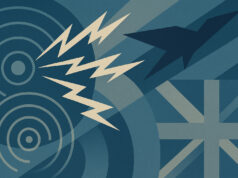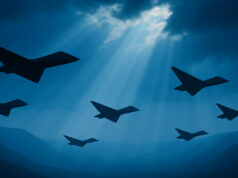The Royal Navy have always been at the forefront of carrier design evolution though are now having to play catch up to get back into the carrier game.
In the 1980’s the Royal Navy was relegated to operating the small “pocket carrier” Invincible class leaving the large carriers behind until 1998 when it was decided two new big carriers would replace them. Though that is not to say that the Invincible class were bad by any stretch as it comes down to the operations that you wish to use them for as during the cold war the Royal Navy was primarily an ASW navy which the Invincible class were designed for.
But now the Queen Elizabeth will return the Royal Navy to blue water operations as threats that are faced are no longer from a single enemy as in the Cold War but small terror groups to heightened regional tensions.
Vessels that can deploy anywhere and strike almost anywhere are needed but for that more powerful aircraft than the Harriers are needed which needs a more powerful ship to launch them.
A bigger ship means more men, more supplies, more space and more sorties.
As the QE class at maximum load can house a complement of 1,600 so we would have more pilots and engineers on-board to fly the sorties and maintain the aircraft. So in combat conditions the same selection of pilots would not be flying repeated missions and taking the physical and mental toll.
More work can be taken on the aircraft to maintain them but there are also more aircraft available so the stress on the same aircraft is lowered as the missions are spread.
Further to this, the higher aircraft numbers means that more aircraft can be used for operations, as some aircraft will be needed for a Combat Air Patrol to protect a task group; meaning less aircraft for operations which would be very serious for a carrier with only 9-12 aircraft embarked.
This was an issue that was encountered during the Falklands War as to provide enough Harriers for a CAP and missions we needed both the Invincible and Hermes together as a single task group.
What all this means is that the Queen Elizabeth Class carriers will be able to spend more time on station in a potential combat zone.
They will be able to bring not only just more aircraft to bear on the targets but, more importantly, more sorties at a higher sustained rate.














You really get a sense of the sheer scale of the Queen Elizabeth class carriers when you see them next to the invincible class carriers. It’s about time the UK invested more in its armed services. The RAF need to also initiate a sixth generation fighter concept. However, to drive innovation in cost effective sixth generation fighters we really need to set industry the challenge of keeping costs low. I believe this is relatively easy to do if the UK is developing a fighter on its own. Therefore, the UK should go on its own with a sixth generation fighter to maintain capability in this area. Alternatively we should go 50:50 with the US so we get a higher proportion of the industrial impact. We can do that if the defence budget is at least 3% GDP. I would suggest curtailing DFID and reducing the 0.7% of GDP spend on foreign aid as a starting point to fund this increase. The 0.7% is essentially wasted money anyway going on foreign dictators.
Agree with you regards the size of the QE. I actually went aboard the Invincible and thought she was big, but compared to the former she come across as small. That said you would have thought with the size incrase they would have made the Ski ramp wider as that F35 mock-up only just fits on it. Also I feel the RN missed a trick on not having a bow like on its smaller sibling allowing them to fit a CIWS there. (and the solitary guard as spotted on many happy snaps)
But hey hum.
After CVA01 was cancelled, the term “aircraft carrier” went out of favour in the MOD, and the Invincibles were initially referred to as “through-deck cruisers.” I can remember seeing artists’ impressions circa 1973 of what the Invincibles would look like, showing both a Sea Dart twin launcher and 4 Exocet tubes fitted. Also, the purpose of embarking Sea Harriers was to protect the carriers and to intercept Soviet recon bombers.